#and more traditional filmmaking
Text
[Filmmakers, pro tip. If you're going to do a "Found footage" movie, marketed as found footage, and shown almost entirely as found footage for like the first 20 minutes, KEEP IT FOUND FOOTAGE.
I know most of this movie is found footage but as it goes on, more and more of the perspective is from an "out of universe" camera and it's just...disappointing??? No one wants half assed found footage. It'd be one thing if there's one segment that's found footage and the rest is entirely regular footage, or something in universe is found footage (isn't that how the show Archive 81 is? the main story is out of universe but the videos watched are found footage? that's fine).
But like...not this weird mashup. No one wants this. It annoys found footage fans and people that don't like found footage aren't gonna be more likely to watch for the bits that aren't found footage.]
#horror#found footage#the pyramid#yes i'm happy to finally get to this movie and i do actually quite like it#but i'd always been led to believe it's full found footage when it's not#and as we get closer to the end there's less and less found footage#and more traditional filmmaking
10 notes
·
View notes
Text
finally watching Barbarian (2022) and this man has negative charisma tbh. incredibly funny to cast a man this good looking in a role like this.
#james talks#james watches stuff#barbarian#barbarian 2022#watch the stupid ass twist be he's some fucking virgin 500 year old or something and why he uses 'young lady'#man has so many fucking red flags#like he's trying to be genuinely nice but it also reads as such huge blaring sirens#casting a skarsgard brother for this was an incredible choice btw#also tbh so far the filmmaking is fun but i don't know what it really wants to be like if it's trying to be traditional horror or—#despite my distaste for the term it has unfortunately stuck around in the discourse so forgive my usage but—#it wants to be more cerebral or like 'elevated horror'#anyway uh the opening had some really bad fake rain#back to the movie i go
14 notes
·
View notes
Text
'54 Goji in honor of Monster March and Minus One's incredible Oscar win last night. I'm so proud history was made <33333

#traditional art#godzilla 1954#I'm so proud of the godzilla team!!!!!! they all did so good#thank you takashi yamazaki for giving aspiring filmmakers around the world even more hope for their future
3 notes
·
View notes
Text
as someone with an interest in costume design, i'm fascinated by goncharov's quasi-nostalgic aesthetic. so many of the clothing choices seem intentionally anachronistic for a soviet crime thriller, not to mention the color palette.
in 1973 this would've been a contemporary drama, and there's an obvious overlap with the wave of early-70s paranoia thrillers (klute, the parallax view) and american cinema generally becoming obsessed with gritty crime dramas. you can absolutely see why scorsese was attracted to this project, but of course, a) this isn't an american movie emerging from american trends, and b) a lot of goncharov's visual choices aggressively *reject* the kind of gritty urban modernity we associate with 1970s movies about sad doomed violent men.
goncharov takes place in the late 1960s or early 1970s, but while katya and andrey's styling is *very* contemporary, goncharov himself is consistently dressed in very sharp early/mid-20th suits and hats. he doesn't even seem to wear synthetic fabrics.

maybe this is just meant to signal that goncharov has very picky (and eccentric) taste in clothes, which falls into a long tradition of antiheroes with snappy signature outfits. (jean-pierre melville's le samouraï came out 2 years before this.) sometimes filmmakers just want their protagonists to Look Cool. however i'm inclined to think there's something more going on here on a thematic level, especially when you combine goncharov's costumes with all the sepia-toned scenery and faux-historical production design elements. the story is rooted in contemporary 1970s politics but goncharov himself is stuck in the past, following a narrative arc that is clearly preordained from the start. so on a thematic level, matteo jwhw7015 is almost positioning him as the protagonist of a historical drama.
5K notes
·
View notes
Text
Another interesting article about the new Ghibli film Boy and the Heron with great insights into Miyazaki’s relationship with Joe Hisaishi and Toshio Suzuki making films over the years. Again it has a few spoilers
What’s it like to work with Hayao Miyazaki? Go behind the scenes.
News of Hayao Miyazaki’s retirement can’t ever be trusted.
The Japanese animation master’s repeated claims that he’ll give up filmmaking are a response to the strain that creating each of his largely hand-drawn universes entails. At least that’s what Toshio Suzuki, a founder of Studio Ghibli and Miyazaki’s right-hand man for the past 40 years, believes.
"Every time he finishes a film, he’s so exhausted he can’t think about the next project,” Suzuki explains. "He’s used up his energy physically and mentally. He needs some time to clear his mind. And to have a blank canvas to come up with new ideas.”
A decade after 2013’s "The Wind Rises” was heralded as Miyazaki’s final film, the 82-year-old auteur’s newest feature, "The Boy and the Heron,” is being released in the United States after major success in Japan over the summer, where it opened without any traditional publicity.
Though the director hasn’t given any interviews about "The Boy and the Heron,” Suzuki, 75, who is also a veteran producer, and Joe Hisaishi, 72, the longtime composer on Miyazaki’s movies, describe in separate video interviews the master’s working process and how their collaborations have evolved — or not — over the years.
Suzuki is casually dressed and speaking, via an interpreter, from Japan, where he sits next to a pillow emblazoned with Totoro, the bearlike troll that serves as the studio’s logo. He says the new fantasy film is Miyazaki’s most personal yet. Set in the final days of World War II, the tale follows 11-year-old Mahito, who, after losing his mother in a fire, moves to the countryside, where a magical realm beckons him.
"At the start of this project, Miyazaki came to me and asked me, ‘This is going to be about my story, is that going to be OK?’ I just nodded,” Suzuki recalls with the matter-of-factness of someone who’s learned it would be futile to stand in the way of the director.
For a long time, he says, Miyazaki worried that if he made a movie about a young male, inspiration would inevitably be drawn from his own childhood, which he felt might not make for an interesting narrative. Growing up, Miyazaki had trouble communicating with people and expressed himself instead by drawing pictures.
"I noticed that with this film, where he portrayed himself as a protagonist, he included a lot of humorous moments in order to cover up that the boy, based on himself, is very sensitive and pessimistic,” Suzuki says. "That was interesting to see.”
If Miyazaki is the boy, Suzuki adds, then he himself is the heron, a mischievous flying entity in the story that pushes the young hero to keep going. Director Isao Takahata, Studio Ghibli’s third foundational musketeer, who died in 2018, is represented onscreen by Granduncle, a wise but weathered figure who controls the fantastical world Mahito ventures into.
Suzuki first met Miyazaki in the late 1970s, when the animator was making his first feature, "Lupin III: The Castle of Cagliostro,” an amusing caper. Back then, Suzuki was a journalist hoping to interview him.
But Miyazaki, who was working on a storyboard, had no interest in talking and ignored him. "Out of kindness, I thought it was a good thing to introduce his works to my readers, and for him to be very cranky and disrespectful, I was very angry,” Suzuki remembers.
He stuck around the studio for two more days of silence. On the third, Miyazaki asked him if he knew a term for a car overtaking another during a chase. Suzuki’s reply, a specific Japanese expression for such action, finally broke the ice and kick-started their long-term relationship.
"Miyazaki still remembers that first meeting, too,” Suzuki says. "He thought that I was a person not to be trusted. And that’s why he was very cautious about talking to me.”
Over the years, Suzuki has become increasingly indispensable for Miyazaki. "He always tells me, ‘Suzuki-san, can you remember the important things for me?’ And then he feels that he can forget about all the important things not concerning his films. I have to remember them for him,” Suzuki says.
Best friends more than mere collaborators, Miyazaki and Suzuki talk every day, even if there’s nothing urgent to discuss, and make it a rule to meet in person on Mondays and Thursdays. "What we talk about is very trivial most times, I guess he feels lonely or misses me, but it’s always him who calls me. I never call him,” Suzuki says, adding with a laugh, "Sometimes he even calls me in the middle of the night, like at 3 a.m., and the first thing he says is, ‘Were you awake?’ And obviously I was not. I’m in bed!”
In contrast, Hisaishi, the composer who first worked with Miyazaki on the 1984 feature "Nausicaa of the Valley of the Wind,” has a strictly professional relationship with him.
"We don’t see each other in private,” Hisaishi, wearing an elegant sweater, says through a translator. "We don’t eat together. We don’t drink together. We only meet to discuss things for work.” That emotional distance, he adds, is what has made their partnership over 11 films so creatively fruitful.
"People think that if you really know a person’s full character then you can have a good working relationship, but that doesn’t necessarily hold true,” Hisaishi says. "What is most important to me is to compose music. The most important thing in life to Miyazaki is to draw pictures. We are both focused on those most important things in our lives.”
On "The Boy and the Heron,” Miyazaki didn’t provide Hisaishi with any instruction. The musician watched the film only when it was nearly completed but still with no sound or dialogue. At that point Miyazaki simply said to Hisaishi, "I just leave it up to you.”
"I feel he was just thinking that he could rely on me and expected me to come up with something,” Hisaishi says. "I feel like I was very much trusted to do this.”
For all of their previous collaborations, Miyazaki would bring on Hisaishi to discuss once three out of the four or five parts of the storyboard for a new film were ready. That the process changed this time was possible only because of their shared history.
"It’s as if we’ve been Olympic athletes making a film once every four years for 40 years,” Hisaishi says. "It’s been a long time of training and performing. When I look back I’m amazed that I could write music for these very different films.”
In his contemporary classical work, Hisaishi had been working on minimalist compositions with repeating patterns, and he took that approach to the new film.
While he maintains they are just colleagues, every January for the past 15 years, Hisaishi has composed a small tune, recorded it on a piano and sent it to Miyazaki as a birthday present. This tradition has now become the seasoned musician’s lucky charm.
"After about three times I thought, ‘This has probably run its course,’” Hisaishi recalls. "I didn’t send one the following year. That whole year I wasn’t able to work very well. It was sort of a jinx that I had not sent him something, so I started sending him the music again for his birthday,” he adds with a laugh.
Both Hisaishi and Suzuki say their interactions with Miyazaki have not changed much over the decades. On the contrary, the men have become staunch creatures of habit.
Asked why his profound connection with Miyazaki has endured so long, Suzuki says: "I don’t necessarily agree, but he once told me, ‘I’ve never met someone so similar to me. You are the last person that I will meet like that.’”
BY CARLOS AGUILAR
THE NEW YORK TIMES
243 notes
·
View notes
Text
How do you protect a culture that is being wiped out?
For Uighurs, this is more than just a hypothetical. Repressive measures against the ethnic minority have progressively worsened: The Chinese government has corralled more than 1 million of them into internment camps, where they have been subjected to political indoctrination, forced sterilization, and torture.
The targeting of the Uighurs isn’t limited to the camps. Since 2016, dozens of graveyards and religious sites have been destroyed. The Uighur language has been banned in Xinjiang schools in favor of Mandarin Chinese. Practicing Islam, the predominant Uighur faith, has been discouraged as a “sign of extremism.”
Beijing frames these moves as its way of rooting out terrorism, separatism, and religious extremism. But the aim of China’s actions in Xinjiang is clear: to homogenize Uighurs into the country’s Han Chinese majority, even if that means erasing their cultural and religious identity for good. What is taking place is a cultural genocide.
The repercussions bear heavily even on Uighurs living outside the country. Their burden is more than just raising awareness about what is taking place in their homeland—a task many have taken up at great cost to themselves and their families. It’s also about preserving and promoting their identity in countries where few people might know who the Uighurs are, let alone what the world stands to lose should their language, food, art, and traditions be eradicated.
In an effort to understand what this kind of cultural preservation looks like in practice, I spoke with seven Uighurs residing in Britain, France, Turkey, and the United States. As chefs, poets, singers, filmmakers, language teachers, and musicians, each of them is contributing to this work in different ways. All of them are passionate about ensuring that their heritage will be passed on to future generations. None of them is under any illusions about what’s at stake if they fail.
“Every Uighur now is under very big psychological pressure,” Omer Kanat, the director of the Uyghur Human Rights Project, a Washington, D.C.–based nonprofit, told me. “We cannot sleep at night.”
#current events#culture#genocide#cultural genocide#oppression#diaspora#islamophobia#uyghur genocide#xinjiang#uyghurs
332 notes
·
View notes
Text
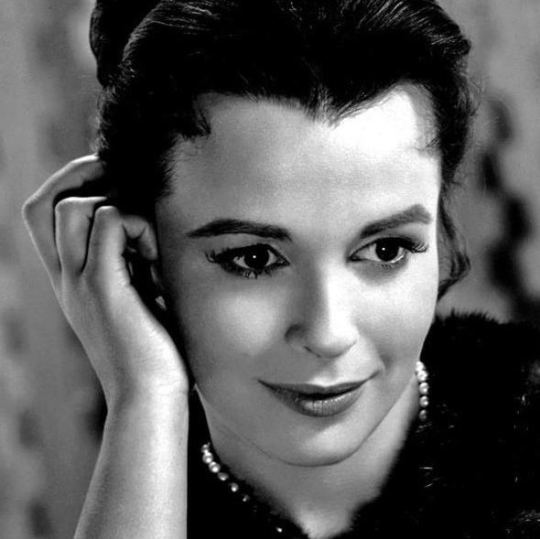
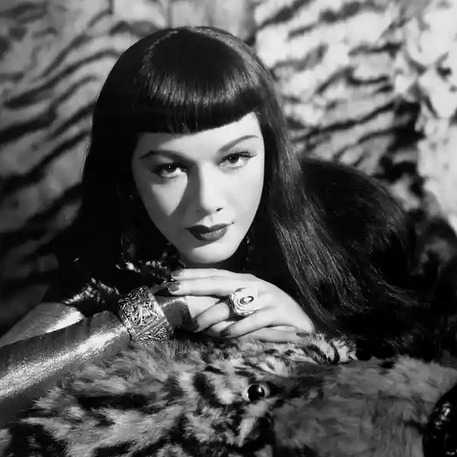
Propaganda
Claire Bloom (The Haunting of Hill House)— She played a hot sarcastic psychic lesbian in a haunted house! What more do you need?
Maria Montez (Cobra Woman, Arabian Nights)—maria montez was a dominican actress who rose to fame starring in a series of technicolor adventure movies in the 1940s hollywood, becoming popularly known as "the queen of technicolor”. her dramatic persona and elaborate bejeweled attire in these films subsequently lead to her becoming an early camp icon to underground queer filmmakers like jack smith and andy warhol. maria was fiercely determined to become a Movie Star from early on and tirelessly promoted herself (she would be killing it as an influencer today probably) - she deliberately cultivated an outré star persona in the tradition of old school screen vamps like theda bara and alla nazimova and she was always serving no matter where she was or what she was doing.
This is round 1 of the tournament. All other polls in this bracket can be found here. Please reblog with further support of your beloved hot sexy vintage woman.
[additional propaganda submitted under the cut]
Maria:
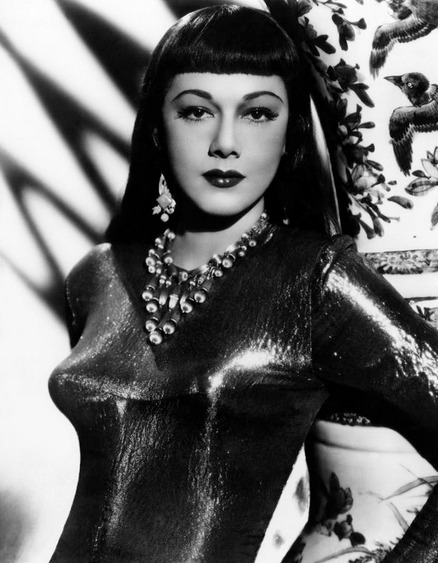
Dominican actress dubbed the Queen of Technicolor. Starred in colourful action adventure movies and was Universal Studios “glamour girl” of the 1940s. She starred in 26 movies before her untimely death in 1951. Shot to stardom with Arabian Nights in 1942. Fought with universal over roles she was cast in and managed to negotiate better pay for herself before going freelance and starring in European movies.

82 notes
·
View notes
Note
Hi Slug!! I'm curious about some of the religious imagery in hypmic! Kuko is obvious and I think Doppo has talked about not believing in gods before but what's up with Jakurai? Is he meant to actually be Christian or is it just an aesthetic thing?
This ended up being so long Tumblr wouldn't let me put it all in one post. Hoo boy. Under a cut for length.
Usual disclaimer that I don't live in Japan, so I'm not talking about IRL Japan so much as Japanese media. Media isn't perfectly synonymous with real life and, of course, it's foolish to draw conclusions from the general (media and culture) and apply them to the specific (individual persons). With that being said, media is indicative of real life values and cultural concerns--for example, the American high school experience is a lot less interesting than in movies, but these movies reflect a romanticization of teenagehood so widespread in the US and areas with heavy US cultural influence that filmmakers take it for granted in their audiences--so I can talk about what assumptions inform the portrayal of religion in Hypmic.
As in a lot of Japanese media, religion is present but not explicitly mentioned outside of Kuukou. It's what I would call culturally religious as opposed to actively religious. Similar to how many works in the Anglosphere are steeped with Christian ideas and phrases even if the authors/works themselves aren't Christian (the Christian concept of sin, using "God" or variations as an interjection, etc.), many works written in Japanese are influenced by Shinto and Buddhist ideas.
Some people in Japan are active worshipers of Shinto, Buddhism, or both, but many more have a somewhat relaxed approach. It's not uncommon for people to have a belief in a higher power, but the nature of this higher power isn't terribly well-defined. Many people will attend religious ceremonies for holidays or funerals but rarely pray to a higher power outside of moments of great stress. That is, being culturally religious. Traditions are fun and comforting, especially if they involve dressing up in fancy clothes, eating yummy food, and seeing friends and family. Even if you're not especially devout, it doesn't hurt to pray for a bit of luck before a big test, that your child will grow up healthy and strong, or that your recently departed ancestor will be at peace. For those in predominately Christian areas, you probably see plenty of this in your community--people who maybe go to church occasionally for companionship or holiday celebrations but aren't active worshipers. Or, perhaps, people who pray like, "Hey, if anyone's listening, can you lend me a hand?" Maybe you're even one of these people yourself.
We can generally assume that most of the cast falls into this camp. Doppo and Hifumi go to a festival with a religious element--charms and rituals to bring good luck by appealing to Shinto deities--but I doubt either of them have a firm belief that these particular deities exist. They may think that there's some higher power...or not. But what's the harm in a good luck charm, right? And more importantly, it's fun to play games, eat, drink, and horse around with friends!
But wait, does that mean these two are only Shinto or...Shinto-ish? Probably not. There's an expression that most Japanese people are "born Shinto, but die Buddhist." Shinto rituals tend to focus on matters of the living (although Shintoism has its own distinct funerary rites, sometimes combined with Buddhist rites), while non-devout Buddhists usually participate in Buddhist ceremonies only when loved ones die. We see Juushi and Hitoya with loved ones buried in Buddhist cemeteries, but it's safe to assume both observe Shinto holidays and customs in some fashion. We also see in the very beginning of TDD that Nemu and Samatoki have what appears to be a butsudan--a Buddhist altar--in their home dedicated to their deceased parents. "But wait," some might say, "I thought spirit worship isn't a part of Buddhism." That's true for some forms of Buddhism, but not all! Buddhism is enormously varied, and some of the (many, many!) forms of Buddhism practiced in Japan accept aspects of Shintoism. There's plenty of mixing, just as we see within individuals themselves. Again, the Hypmic characters may not fully believe that spirits exist. (Well, outside of Ramuda...) But it's a comforting thought that one's deceased family members are around in some form and can be a positive influence on one's life.
72 notes
·
View notes
Text
The Power of Stop-Motion
Media in today's standard is quick and easy. Rarely is a show more than 2 hours long or 13-epiodes per-season. With that, animated movies are a lot slower than the typical films.
There is a discussion on if animation is suitable for film purposes and while it is often shunned by the Golden Globes or the Oscars or other awards. The very few outliers can prove these awards and the world very wrong.
But that is not what we will be talking about today. Because while animation is popular, there is a dark horse among its sphere. One with a rich history and strong filmography that should be shared. Let's talk about;

- Have I possibly gone daffy? -
Stop-motion is a film making style that compiles multiple still images of an object being physically manipulated in small movements into one whole scene.
Majority of Stop-motion films and videos use [Clay Animation] or [Paper Animation] with several more varieties of new innovations emerging under the umbrella of stop-motion. The most popular of them in the modern era towards kids is [Lego animation] which is the manipulation of Lego models in motion.

The earliest trace of Stop-motion in films is the 1898 short [The Humpty Dumpty Circus] by Albert E. Smith and James Stuart Blackton which is said to be a lost media. To compensate, please watch [A Tribute to Stop Motion]
In its early concept, Stop-motion was used as a method to create impossible things or do practical effects under budget constrains. Such as the iconic King Kong scene at the Empire State building. Since then, Stop-motion has evolved into a full production industry. From Indies; [Righteous Robot] to Juggernauts; [Laika Studios]
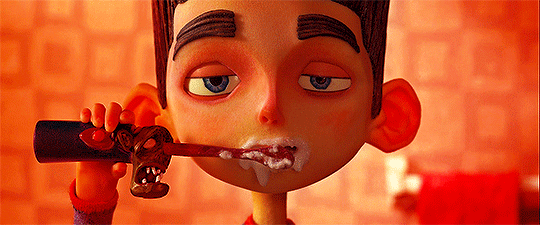
- Shimmer a Little at The Edges -
Unconventional media such as stop-motion is often not a style suited for every story. Its a rather expensive type of media that requires worthy innovations top break the niche barrier. Just looking at Laika Studios alone, we see that they've develop a lot of interesting ways to improve visual effects while staying to their stop-motion roots.
One perfect example is seen in < Kubo and the Two Strings > where the animators need to create water in a still image world that feels natural. [A Perfect Storm] one other part of the stop-motion puzzle is the iron-willed discipline it to conceptualize, animate and edit a production that can take about 3 to 5 years to complete. More so of a time frame than a normal film.

This difficult curve lead to budgeted methods such as using models that already exist to tell new stories. Such as; Legos or with crude multi-jointed figures of existing characters. [MOONSHINE]
While I may say its crude, the low budget production is the selling point. Assisted with sound bites taken from gaming sessions or from shows featuring a lot of inside jokes and memes. Also, its hilarious to see a Teletubby turned into a Eldritch monster.
These attempts to make stop-motion productions accessible has captured the attention of other like-minded channels to collaborate and elevate one another. [ERB: Harry Potter vs Luke Skywalker]

- For Better Tomorrows -
With all that is said, what is the power of stop-motion? As a media that is tediously overlapping across processes. What are the better tomorrows for our inanimate subjects?
I like to think, that as filmmaking grows. Stop-motion will continue to remain as a sacred tug against live action films and traditional animation. It can be used to tell complicated stories with concepts that may look strange if its adapted in a live action.
As I have mentioned in [The Beautiful World of Hilda] animation's greatest strength is simplification. Stop-motion takes the opposite side of that philosophy.

Its a higher level of world building of the materials with willingness to accept mistakes and ruggedness that gives them that little flavor of life. As an actual touchable thing, the various cartoonish styles can take on a whole new dimension to heighten the style and give it that detail that is less polished.
Stop-motion shows that filmmaking magic can still exist despite already knowing the tricks. Its a media where every frame shown has a significant purpose that invokes a specific flow. That's the power of stop-motion.


#stop motion#stop motion animation#coraline#coraline jones#lego animation#clay animation#paper animation#laika studios#paranorman#norman babcock#the lego movie#emirichu#daidus#moonshine animations#pinocchio#guillermo del toro#wendell and wild#Guillermo del Toro's Pinocchio
48 notes
·
View notes
Text
"We are thrilled to announce the launch of the Garifuna International Indigenous Film Festival (GIIFF) on November 9th-November 12th, 2023, a groundbreaking initiative dedicated to supporting and preserving the Garifuna nation and all indigenous cultures being held at the Electric Lodge located in Venice, California.
This unique film festival will create a platform for filmmakers, artists, and community leaders/members to showcase their works while emphasizing the importance of cultural diversity and representation. The Garifuna people, originating from the Caribbean Island of St. Vincent, possess a rich tradition and enduring heritage that deserves global recognition. The Garifuna International Indigenous Film Festival aims to bring this vibrant culture to the forefront and shed light on the struggles and triumphs of the Garifuna nation and other indigenous communities worldwide.
The underlying objective of GIIFF is to promote a deeper understanding and appreciation of indigenous traditions, values, and stories. Through the power of film, GIIFF aims to bridge gaps, foster dialogue, and debunk stereotypes surrounding indigenous cultures.
This multidisciplinary approach will not only provide a unique experience for audiences, but it will also contribute to the preservation of cultural heritage for future generations.
GIIFF will feature a diverse selection of thought provoking-international films, documentaries, workshops, cultural presentations, and short films that center around indigenous cultures. The festival strives to create an inclusive space, where filmmakers and artists can engage with industry leaders, intellectuals, and audiences who share a passion for the sense of community and collaboration, encouraging meaningful conversations and connections.
This inclusive space not only allows industry leaders and intellectuals to engage with these powerful stories but also invites audiences from all walks of life to immerse themselves in the beauty and diversity of indigenous cultures. The GIIFF is more than just a film festival; it is a celebration of heritage, resilience, and the power of storytelling."
-via Garifuna Indigenous Film Festival, October 2023
#indigenous#first nations#indigenous peoples#indigenous history#garifuna#caribbean#carribbean#film festival#los angeles#st. vincent#cultural heritage#documentaries#good news#hope
129 notes
·
View notes
Text
i have this on my draft for a while a thread of some specific zorobin images, panels or scenes because they are so good together and my shipper's brain is working overtime so there's that. 😅💚💜⚔️🌸
Exhibit 1:
if not endgame, why drew them like this? this is such a husband/wife stance with their kid.
a family portrait - zoro looking like a serious dad, robin an obedient wife - she's in heels that's why she couldn't sit all the way with her feet tucked underneath like a traditional wife. and chopper as their son with his cute little bagpack. they're so effing married y'all. 😭
oda is playing with my shipper's heart. 🥲

Exhibit 2.
them playing Go from One Piece opening 12. a game which originated in asia mostly known and popular in china, japan, and korea.
since zoro is japanese and robin is russian we can guess that zoro asked robin to play with him. robin beating him is so funny even the dog pity him. lol 😂
i can't, toie!!!! why would you animate them like a normal couple whose having a fun and casual date!!!!

Exhibit 3.
another images of them looking like a husband and wife with their daughter.
this shot is very intentional and targets me for some reason. 😉🤔
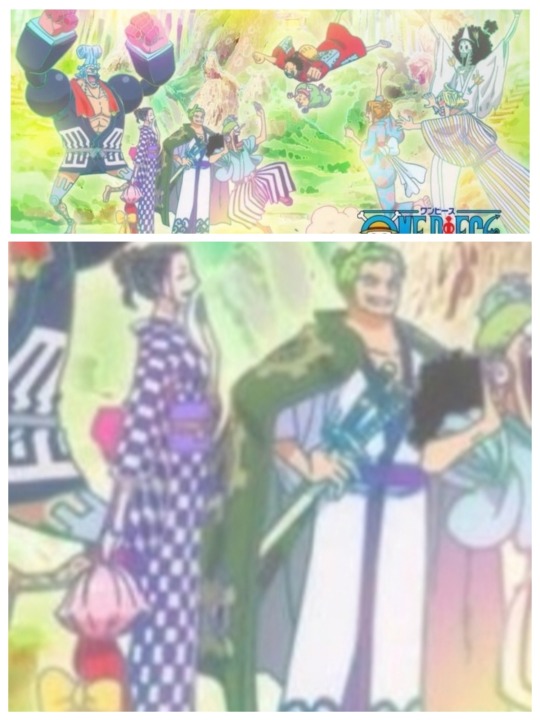
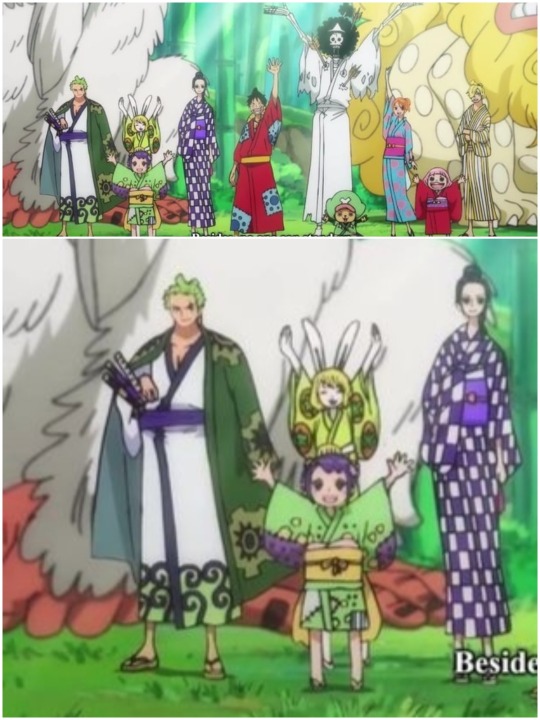
toko is more connected to zorobin but why toie intentionally placed tama in the middle? tama's motif is green + purple zorobin's color and here she's looking more like their daughter. carrot's yukata is yellow-green with more greenish design - she's slightly far back and thin that you cant even notice her at first glance and the focus is more with zorobin + tama here.
if you are familiar with the rule of thirds in filmmaking some shots are purposely done for emphasis and show relations between subjects/objects in a frame.
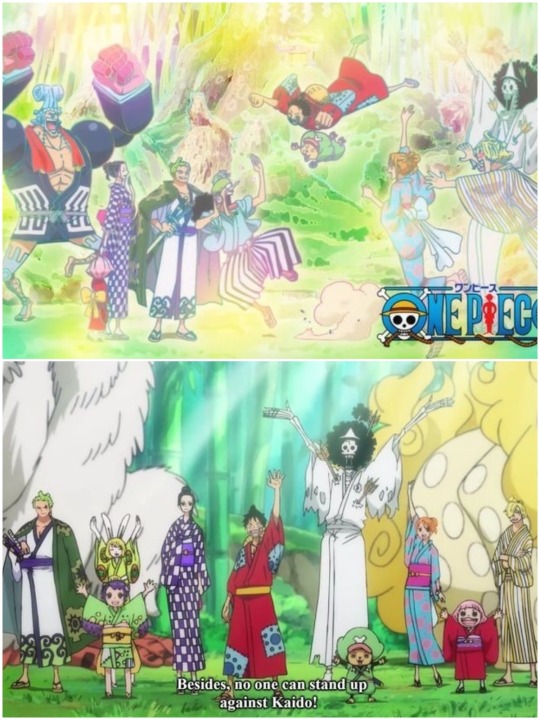

to have a visual comparison, see sanami + toko and luffy/brook/chopper - the colors do not look harmonious. they were intentionally groups in 3s. carrot is straight behind tama that they look like one person.
sanami in the shot above parallel zorobin with a kid placed in between them. also, both couples in each sides of the picture.
while toko'a motif is red + pink, matching lunami in this pic. luffy yukata red + blue, nami's sky blue + pink patterns. for visualization, exchange luffy with sanji and you'll see what i mean with the colors matching the clothes.
anyway, someone in the animation dept is definitely hiding as a zorobin shipper for sure. 😂🤭🤫
Exhibit 4:
specific images drawn originally in opposite positions or away from each other but if you flip and edited together they just happened to fit so well. ain't that too convenient 🥹🤔🤭
i found them on pinterest and i was like why does this image fit so well without trying to. kudos to the original editor. 🥰😍
left side the original image. right side edited.

see the difference? the other characters, if you rearrange them it will look jarring and will not have the same effect.
while zorobin over here looks pretty cozy in hindsight. you'll never know that it's not the original image.
oda intentionally drew them like this and thought we wouldn't notice. 🤔😎🤭
Exhibit 5:
when i saw this one, i had to double take cos i really thought robin was holding zoro's arm. her head slightly leaning over to his shoulder.
toie, you ship-baiting sons of b@#$! had me screaming zorobin confirmed for a hot second. 🥲🫠
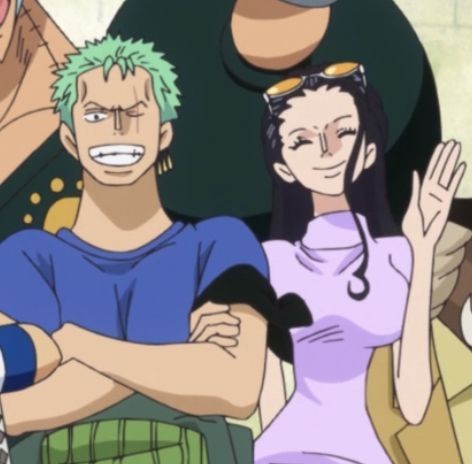
Exhibit 6:
the classic hero and damsel trope
the original image was with other characters but if you isolate, the emphasis on these two was undeniable.
take note of the placement of the characters to one another. their facial expressions and body language.
zoro in a crouching stance with his swords drawn across and his face serious. robin's beside him looking sad with her hood on.
the hero is angry serious and his troubled damsel.
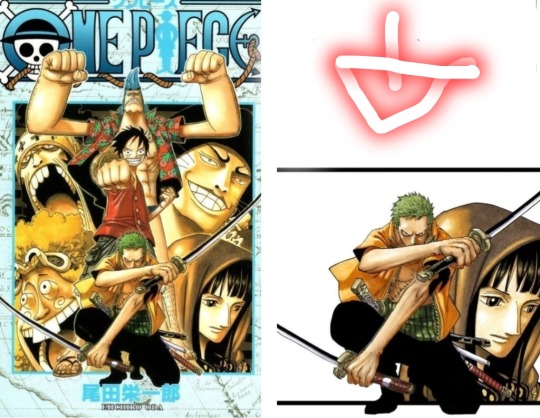
oda's no-romance-among-the-crew but keep drawing zorobin with subtle lover undertones will be the death of me. 🙄😫🤡
if this is not one piece, this image on the right is a common trope in storytelling mostly seen in movie posters or book covers. right in the center is the hero and then the woman at the side is the love interest.
and mind you this image is a cover spread during the enies lobby where robin bares her heart and the strawhats save her. and who got the last key that "freed" her?*cough*zoro*cough*
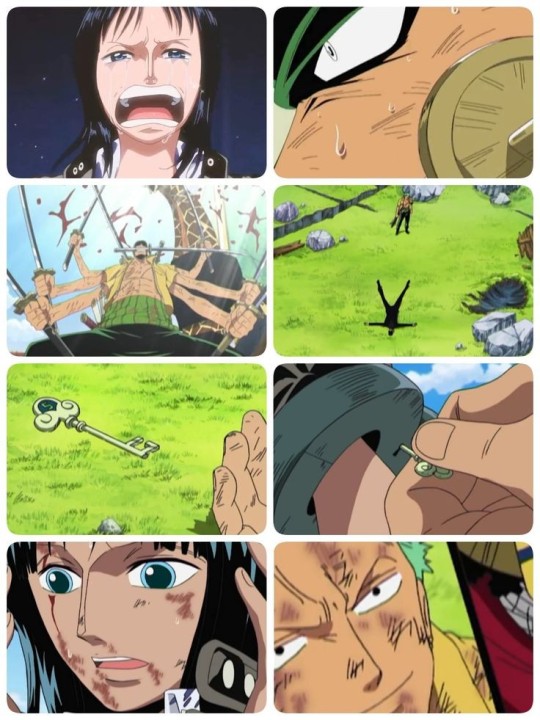
in my mind, all the images above are just so intentional that my instinct will point yup that's otp for sure. 😂🤭😅🤫🥲🤔
anyway, this thread is 60% side comments, 10% attempt to do an analysis, 30% blaming oda/toie for being such a tease and shipbaiter.
i will make another post like this cos its fun ahahaha. 😁😎
#zorobin supremacy#zorobin brainrot#im just a delulu shipper that likes to spread zorobin agenda#missing zorobin hours#normalize shipping zorobin for clear skin#zorobin#zoro x robin#roronoa zoro x nico robin
35 notes
·
View notes
Text
September 11, 1973: On the 50th Anniversary of the Coup in Chile
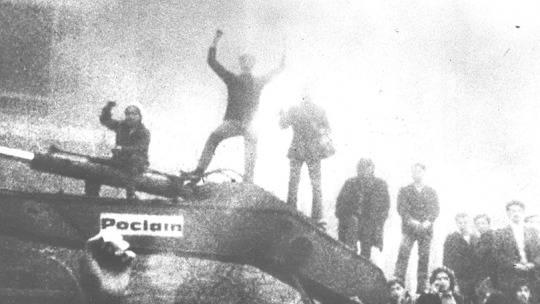
Today marks the 50th anniversary of the coup d’état in Chile, when a fascist junta led by dictator Augusto Pinochet overthrew the democratically elected socialist government of Salvador Allende. For those of us who are on the left, the story should be familiar by now: Allende had charted a ‘Chilean way to socialism' ("La vía chilena al socialismo") quite distinct from the Soviet Union and communist China, a peaceful path to socialism that was fundamentally anti-authoritarian, combining worker power with respect for civil liberties, freedom of the press, and a principled commitment to democratic process. For leftists who had become disillusioned with the Soviet drift into authoritarianism, Chile was a bright spot on an otherwise gloomy Cold War map.
What happened in Chile was one of the darkest chapters in the history of US interventionism. In August 1970, Henry Kissinger, who was then Nixon’s national security adviser, commissioned a study on the consequences of a possible Allende victory in the upcoming Chilean presidential election. Kissinger, Nixon, and the CIA—all under the spell of Cold War derangement syndrome—determined the US should pursue a policy of blocking the ascent of Allende, lest a socialist Chile generate a “domino effect” in the region.
When Allende won the presidency, the US did everything in their power to destroy his government: they meddled in Chilean elections, leveraged their control of the international financial system to destroy the economy of Chile (which they also did through an economic boycott), and sowed social chaos through sponsoring terrorism and a shutdown of the transportation sector, bringing the country to the brink of civil war. Particularly infuriating to the Americans was Allende’s nationalization of the copper mining industry, which was around 70% of Chile’s economy at the time and was controlled by US mining companies like Anaconda, Kennecott and the Cerro Corporation. When the CIA’s campaign of sabotage failed to destroy the socialist experiment in Chile, they resorted to assisting general Augusto Pinochet's plot to overthrow the democratically elected government. What followed was a gruesome campaign of repression against workers, leftists, poets, activists, students, and ordinary Chileans—stadiums were turned into concentration camps where supporters of Allende’s Popular Unity government were tortured and murdered. During Pinochet’s 17-year reign of terror, 3,200 people were executed and 40,000 people were detained, tortured, or disappeared, 1,469 of whom remain unaccounted for. Chile was then used as a laboratory for neoliberal economic policies, where the Chicago boys and their ilk tested out their terrible ideas on a population forced to live under a military dictatorship.
It shatters my heart, thinking about this history. I feel a personal attachment to Chile, not only because my partner is Chilean (his father left during the dictatorship), but because I’ve always considered Chile to be a world capital of poetry and anti-authoritarian leftism. The filmmaker Alejandro Jodorowsky asks, “In how many countries does a real poetic atmosphere exist? Without a doubt, ancient China was a land of poetry. But I think, in the 1950s in Chile, we lived poetically like in no other country in the world.” (Poetry left China long ago — oh how I wish I’d been around to witness the poetic flowering of the Tang era!) Chile has one of the greatest literary traditions of the twentieth century, producing such giants as Bolaño and Neruda, and more recently, Cecilia Vicuña and Raúl Zurita, among others.

To commemorate the 50th anniversary of the coup, the Harvard Film Archive has been screening Patricio Guzmán’s magisterial trilogy, The Battle of Chile, along with a program of Chilean cinema. I watched part I and II the last two nights and will watch part III tonight. It’s no secret that I am a huge fan of Guzmán’s work, and even quoted his beautiful film Nostalgia for the Light in the conclusion of my book Carceral Capitalism, when I wrote about the Chilean political prisoners who studied astronomy while incarcerated in the Atacama Desert. Bless Patricio Guzmán. This man has devoted his life and filmmaking career to the excavation of the Chilean soul.
Parts I and II utterly destroyed me. I left the theater last night shaken to my core, my face covered in tears.


The films are all the more remarkable when you consider it was made by a scrappy team of six people using film stock provided by the great documentarian Chris Marker. After the coup, four of the filmmakers were arrested. The footage was smuggled out of Chile and the exiled filmmakers completed the films in Cuba. Sadly, in 1974, the Pinochet regime disappeared cameraman Jorge Müller Silva, who is assumed dead.
It’s one thing to know the macro-story of what happened in Chile and quite another to see the view from the ground: the footage of the upswell of support for radical transformation, the marches, the street battles, the internal debates on the left about how to stop the fascist creep, the descent into chaos, the face of the military officer as he aims his pistol at the Argentine cameraman Leonard Hendrickson during the failed putsch of June 1973 (an ominous prelude to the September coup), the audio recordings of Allende on the morning of September 11, the bombing of Palacio de La Moneda—the military is closing in. Allende is dead. The crumbling edifice of the presidential palace becomes the rubble of revolutionary dreams—the bombs, a dirge for what was never even given a chance to live.
#Patricio Guzmán#film#Chile#history#salvador allende#socialism#marxism#coup#coup d'etat#The Battle of Chile#revolution#cinema#fascism#communism#geopolitics#political economy#Cold War#chris marker#memory#neoliberalism#capitalism#politics
97 notes
·
View notes
Note
📖
Hiiiii!! Can i request the prompt 14?

📖𝟏𝟒: 𝐖𝐚𝐭𝐜𝐡𝐢𝐧𝐠 𝐚 𝐇𝐨𝐫𝐫𝐨𝐫 𝐅𝐢𝐥𝐦 𝐰𝐢𝐭𝐡 𝐓𝐨𝐦...
𝐚𝐧𝐝 𝐘𝐨𝐮 𝐁𝐞𝐢𝐧𝐠 𝐓𝐞𝐫𝐫𝐢𝐟𝐢𝐞𝐝 (𝐰𝐡𝐢𝐜𝐡 𝐓𝐨𝐦 𝐟𝐢𝐧𝐝𝐬 𝐚𝐦𝐮𝐬𝐢𝐧𝐠)
𝐺𝑒𝑛𝑟𝑒: 𝑅𝑜𝑚𝑎𝑛𝑐𝑒, 𝐹𝑙𝑢𝑓𝑓
𝐶𝑜𝑚𝑒 𝐽𝑜𝑖𝑛 𝑡ℎ𝑒 1𝐾 𝐸𝑣𝑒𝑛𝑡!
A/N: Of course! Hope you enjoy it! Had a lot of fun writing Tom being an asshole. But we love to see it.
You regretted instantly at the title screen. Days of begging Tom to watch a horror movie with you, ignoring the barely audible groans and eye rolls. ‘Tis the season’ you said, wanting to amp yourself up to the coming Hallowe’en feast.
You loved Hallowe’en. It felt right and appropriate to be a witch, living in a spooky castle, stirring cauldrons and flying on broomsticks. Tom always found muggle’s idea of horror to be cliche, perhaps due to his distaste for the muggle’s version of its celebration. To quote his words, apparently “the muggle’s rendition of our traditions is horrendously cheesy– and not scary.”
Which is why it was surprising when Tom proposed a surprise date and showed you his room turned cinema. He smiled proudly and presented you with three film rolls: the Conjuring I, the Exorcist, and… the Nightmare Before Christmas.
“The last option’s there for you, if you need it,” he raised a challenging brow, attempting to contain his smirk.
You guffawed at the audacity of your boyfriend.
You snatched the film reel from his hands with the barely legible handwriting of the Conjuring I. “Not. Necessary,” you met his challenging gaze on your tiptoes before pushing the reel against his chest.
He bit down on his smile and proceeded to set up the film as you laid down on his bed. The projector faced the large headboard of his bed, making it convenient to lie down and watch the film.
You rested your chin on your hand as he joined next to you.
“Thank you for doing this, Tom,” you beamed at him, despite the former teasing. “I’m going to enjoy this.”
Tom angled his face towards you, taking the moment to observe you with the usual unreadable expression, as if deep in thought.
“You know, I have a good feeling,” he murmured. “Me too,” with one last side glance towards you, he popped a few popcorns into his mouth, and turned his attention to the projection.
You shrugged off his enigmatic response and turned your attention to the projection as well.
Not merely two minutes later, you were already reaching for the large snake soft toy that you’d previously given Tom for Christmas.
This was no skeletons dancing and doing a musical number. This was no Tim Burton.
You clutched the animal as the creepy doll stared at the camera.
“Y/N,” Tom sighed. “Nothing has happened yet.” He did not even have to look at you to know you were terrified.
You scrunched up your nose. “Yes, but we know something is about to happen.”
You waved at the projection, now showing two women fearfully stepping into their apartment. “The lighting, the music.”
“It’s not my fault the filmmakers did a splendid job,” you mumbled and took more popcorn.
You shrieked when there was a loud banging at their apartment’s door, burying your face into the neck of the snake. Unable to take your eyes off, your fearful wide eyes continued to watch the scene.
All of this, Tom watched without a word. Noticing the direction of his gaze, you did a double-take to find him staring at you. At this point, he was no longer watching the film. As his hand reached for more popcorn, you came to realise that he’d found another, better source of entertainment. In his eyes, a shimmer of amusement danced as he watched you jump in terror at more banging on the door.
“Tom!” flabbergasted, you were speechless save for the name of the man who supposedly cared for you.
Tom shrugged nonchalantly, popping a few more popcorn into his mouth. “I did say I’m going to enjoy this,” his words slightly muffled by the popcorn still in his mouth.
You ended up hiding your eyes for the majority of the film. Over the screams and shouts from the film, you occasionally caught him chuckling at you, mumbling something about knowing this were going to happen.
“Tom?” you peeked up towards your boyfriend, momentarily releasing his poor mangled snake.
“Hm?” he responded without looking away from the scene. Apparently, the climax was intriguing enough to warrant his attention.
You fidgeted, the prospect of the coming night suddenly becoming a real and serious problem as it neared the end of the film. It was going to be a long night before the break of dawn.
“Can I sleep with you tonight?”
You guiltily pouted, knowing full well he was going to respond with an annoyed growl, ‘I told you so’, or quite possibly both.
“No.”
You bit your lips. That was cold.
But, knowing the extent he had to go through to set up this date night, it was very understandable.
Trying to gauge whether he was upset with you, you continued to stare at the side of his face, which was revealing no emotion whatsoever as a man got severed in half with a chainsaw.
His eyes flickered over to you, noting your silence.
For a moment, you thought his blank expression faltered. His eyes wavered between yours for a flicker of a second, showing genuine sympathy.
He groaned, finally rolling his eyes away from you.
“Come on,” he swung his arm across your back, pulling you closer to him. So abrupt, your face smushed into his sweatered chest as you fell to your side, eliciting a muffled giggle out of you. You smiled against his sweater which was somewhat scratchier than the snake toy, breathing in the comforting scent of Tom. Shielded in his arm, the film – the screams, the bloodshed, all of it – eventually slipped away from your consciousness.
“Of course you can,” his calm voice echoed above you.
#1k celebration#1k event#1k milestone#1k followers#1K follower event#harry potter#1k follower celebration#tom riddle#tom riddle jr#tom marvolo riddle#tom riddle fanfiction#tmr#tom riddle fanfic#tom riddle x reader#tom riddle imagine#tom riddle x you#tom riddle headcanon#tom riddle headcanons#tom riddle fic#tom riddle x y/n#harry potter fanfiction#tom riddle au#tom riddle fluff
276 notes
·
View notes
Text
Rather than welcoming this break from the status quo, critics dismissed Gummo as nothing more than a glorified “freak show,” totally unaware of how their own deeply ingrained prejudices are refracted through their extended observance of these individuals. It’s also worth noting that the characters most often targeted by this crop of critics were the most comparatively “innocent,” with several remarks on the bodies of women who never acted violently or selfishly in the film—the same ones supposedly being exploited by Korine. However, through merely presenting these people to audiences, the filmmaker makes his point about the overwhelming cruelty and ignorance at the core of American culture. The characters in Gummo might hurl slurs, kill kittens and unplug grandma’s life support, but the flesh-and-blood cultural elite assessing the film for artistic merit had no issue taking pot shots based on (non-)actors’ physical appearances over their involvement in (un-)scripted scenes of a fictional film.
Natalia Keogan, “Gummo and the Tradition of American Cruelty”
81 notes
·
View notes
Text
the well-known cult film pearl (2022) provides, like its precedent film x (2022), an interesting perspective on film, film history, and stardom. first of all, the film is technically beautifully done. it beautifully replicates the feel of an early technicolor film, from the slightly garish color timing to the wipe and iris transitions to the sweeping, full-orchestral soundtrack. whereas x (2022) had a more rough and openly indie feel, visually and tonally drawing on the texas chain saw massacre (1974) and narratively exposing the wires of film creation, this film focuses on stardom in its most abstract, dreamlike state. in many respects, stardom and the cinema are the female version of the american dream—the way a woman can gain financial independence and even financial leverage through hard work and gumption and iron will, or so the narrative runs. as with many post-wwi “american dream” stories, this one centers around what happens when hard work and gumption and iron will are not enough, and when, even if they were, the reward is no reward at all. pearl grows up in the rubble of her parents’ more traditional, my antonia-style american dream, a dream centered around a desire to nurture. pearl’s mother is trapped in a state of constantly, single-handedly nurturing and caring for her husband and her farm, bitter and betrayed by her dream. pearl’s american dream is the twentieth-century dream of stardom: to perform for an audience and be loved for it. and yet, as pearl’s attempt at gumption and struggle for this dream only draws it further away, it becomes clear that to perform itself is agony. pearl is constantly performing a role, and she resents being witnessed and observed—by her parents, by her husband’s portrait, by the projectionist and by mitsy and by the animals on the farm. to be a dancer and an actress, to be, technically speaking, a star, one must relinquish one’s will and play a role for the pleasure of others—precisely as pearl could not bear to do on the farm. this is not the freedom pearl’s fantasized american dream promised. what pearl truly wants to do is not just perform, but to write and direct, to place the people in her life as props and smile big for the camera when she decides it is time for it to turn to her. unlike x (2022), in which those in front of the camera prove to have more power than those behind it, pearl (2022) argues that being a beloved performer is not enough: to truly be an american-dream star according to pearl’s definition, one must also somehow occupy all the other roles in the filmmaking process, or else one is no better than a scarecrow dragged down from its post for a waltz
25 notes
·
View notes
Text

“Doctor Who” star Jodie Whittaker will lead a short film fund aimed at championing female and non-binary filmmakers.
The Empower fund, a community-led initiative backed by Primetime, a global vetted platform to help the industry find and hire more women above and below the line behind the camera, and Bournemouth Film School, was launched at the Cannes film market. It aims to remove the barriers of access to finance and star power that restrict underrepresented filmmakers. The fund will focus on championing female and non-binary filmmakers and grant them access to a minimum of a £10,000 ($12,430) grant in addition to other perks.
Whittaker will feature in or voice the final film, with the intention of increasing the visibility of the project and the filmmaker selected. The actor will also collaborate to create a prompt for filmmakers as a starting point for a character or story she would like to explore. There will be a focus on accessibility and reaching filmmakers who might not traditionally put themselves forward for grant funding. A brief will then be distributed and U.K.-based female and non-binary filmmakers will be encouraged to submit their short film project for consideration. Five projects will be shortlisted via an industry jury, and from that Whittaker will select the live action or animation film she would like to take part in or voice.
The fund will be accessible for any female or non-binary filmmaker who has directed at least three short films, one of which must have screened at a BAFTA or Academy qualifying film festival. The teams applying for funding must adhere to BFI diversity standards in order be considered.
Primetime was launched by actor Victoria Emslie (“Downton Abbey”) at Cannes in 2019 and the platform was relaunched earlier this year. It has members in some 70 countries, including multi-BAFTA, Emmy and Academy Award winners and nominees. Bournemouth Film School, at Arts University Bournemouth, has partnered with Primetime as part of its Funding Futures platform, which houses several funding schemes to support filmmakers, creatives, artists and innovators.
Whittaker said: “Being a part of this exciting journey and having the opportunity to work with talented new voices and creatives is an absolute joy. I can’t wait to work alongside Victoria and the amazing teams at Primetime and Funding Futures.”
Emslie added: “Community-driven change is one of the single most powerful and actionable ways to shake up traditional funding pipelines and the projects that receive finance. By paying in for each other with this focused intentionality, the rise to the top is navigated together as a collective.”
Jonathan Carr, director of the Bournemouth Film School, said: “The success of our groundbreaking Funding Futures schemes hinges on the strength of our partnerships. Our key focus is to encourage positive change within a sustainable industry. We’re delighted to play a pivotal role with Primetime to create a funding opportunity to truly champion inclusivity.”
Will Shutt from Funding Futures said: “The Empower fund hopes to create a space to make a film with filmmakers that reflects the core values of Primetime’s mission. I’m excited to see the outcome of connecting talented filmmakers with Jodie and the award. It can only lead to something special.”
Bournemouth Film School is hosting a Funding Futures showcase event at BFI Southbank on June 16 to unveil the Empower fund.
80 notes
·
View notes